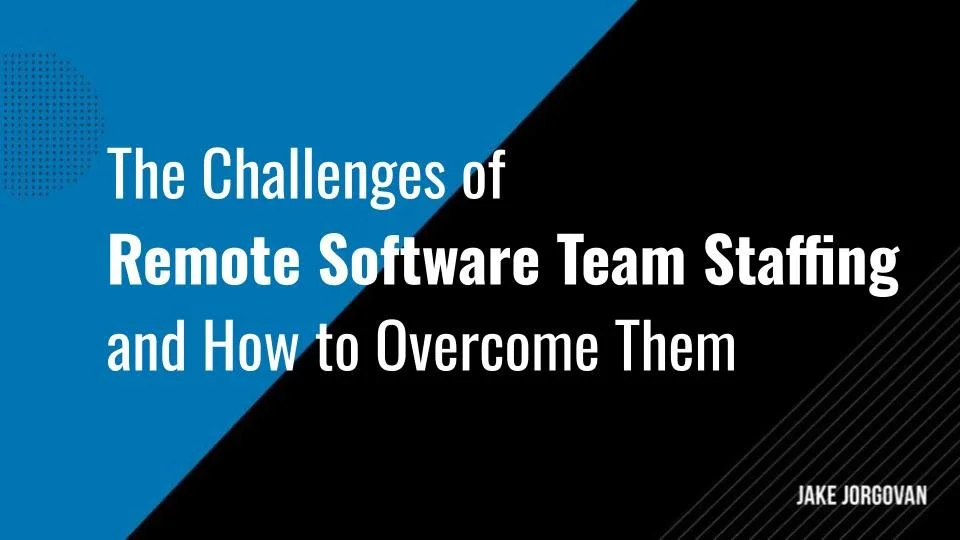Mastering Software Development Staffing: Building a Top-Tier Team
Building a top-tier software development team drives innovation and productivity.
However, mastering software development staffing is no easy task. It requires a strategic approach and keen insight into industry trends.
This article discusses the characteristics of high-performing software development teams and 5 strategies for building them.
Read on to transform your hiring process and enhance your team's capabilities.
Characteristics of High-Performing Software Development Teams
High-performing software development teams share distinct characteristics that set them apart. They exhibit a deep commitment to excellence, driven by a clear vision and shared goals. This commitment translates into consistently delivering high-quality software, meeting deadlines, and exceeding expectations.
Such teams have a balanced mix of skills. Each member brings unique expertise. This creates a comprehensive approach to problem-solving. Collaboration is seamless, with open communication channels that enable quick issue resolution and continuous feedback. This synergy maximizes productivity and innovation.
Agile methodologies play a crucial role. High-performing teams embrace iterative development, which allows them to adapt to changes swiftly. Regular sprints, stand-ups, and retrospectives keep the team aligned and focused on improvement. This helps teams remain responsive and ready to pivot when necessary.
A strong sense of ownership is evident. Team members take responsibility for their work and make sure that tasks are completed to a high standard. This accountability drives a culture of excellence where everyone is invested in the success of the project.
Continuous learning is another hallmark. High-performing teams prioritize skill development and stay current with the latest technologies and best practices. They invest in training, attend conferences, and engage in knowledge-sharing sessions. This dedication to learning keeps the team at the cutting edge of the industry.
Clear communication and transparency are vital. Team members understand their roles and responsibilities, with well-defined processes that minimize misunderstandings. Regular updates and progress tracking ensure everyone is on the same page. This reduces the risk of errors and delays.
5 Strategies for Building a High-Performing Software Development Team
1) Hire Diverse and Skilled Talent
Hiring the right talent is the bedrock of a high-performing software development team. The process is intricate and requires strategic planning. It’s about finding skilled individuals and creating a diverse team that brings different perspectives and innovative solutions to the table. Here’s how to achieve this:
Identify Core Skills and Competencies: Clearly define the technical and soft skills required for the roles. Tailor your job descriptions to attract candidates who meet these criteria, emphasizing the unique aspects of your projects.
Leverage Multiple Recruitment Channels: Use a mix of job boards, professional networks, and recruitment agencies. Engage with platforms that specialize in tech talent and participate in industry conferences and hackathons to find candidates.
Conduct Rigorous Interviews: Design a multi-stage interview process. Include technical assessments, coding challenges, and problem-solving exercises. Assess both individual and team collaboration skills.
Evaluate Cultural Fit: Ensure candidates align with your company values and work culture. Use behavioral interviews to gauge how they handle real-world scenarios and team dynamics.
Offer Competitive Packages: Attract top talent by providing competitive salaries, benefits, and growth opportunities. Highlight your company’s commitment to innovation and career development.
Insider Tip: We’ve found that involving current team members in the recruitment process significantly improves hiring outcomes. Encourage your team to participate in interviews and technical assessments. This ensures a good fit and promotes a sense of ownership and commitment from the existing team.
2) Create a Collaborative Culture
A collaborative culture is essential for a high-performing software development team. It enables seamless communication, enhances problem-solving capabilities, and boosts morale. A well-integrated team can tackle challenges more effectively and innovate faster. Here’s how to get started:
Promote Open Communication: Encourage team members to freely share ideas, feedback, and concerns. Use tools like Slack or Microsoft Teams to facilitate constant interaction. Regular check-ins and stand-up meetings help maintain transparency and alignment.
Build Trust and Respect: Cultivate an environment where team members trust each other’s expertise and respect diverse opinions. Recognize and celebrate individual and team achievements to build confidence and morale.
Implement Collaborative Tools: Utilize software that supports version control, project management, and real-time collaboration. GitHub, Jira, and Confluence are essential for managing code, tracking progress, and documenting knowledge.
Encourage Cross-Functional Collaboration: Promote interactions between developers, designers, testers, and other stakeholders. This ensures a holistic approach to problem-solving and leverages diverse skill sets.
Provide Opportunities for Team Bonding: Organize team-building activities and social events. These can range from casual gatherings to structured workshops, which enhance interpersonal relationships and team cohesion.
Insider Tip: We’ve noticed that dedicating time for 'innovation days' or 'hackathons' where the team can work on projects of their choosing significantly boosts creativity and collaboration. It allows team members to explore new technologies and ideas, which creates a sense of ownership and enthusiasm within the team.
3) Implement Agile Methodologies
Agile methodologies transform your development process into a more adaptive and efficient system. Agile promotes flexibility, continuous improvement, and collaboration. This increases productivity and also enhances product quality. Here’s a step-by-step guide to effectively implement agile methodologies:
Educate Your Team: Start by providing comprehensive training on agile principles and practices. Use workshops, courses, and real-world examples to illustrate how agile can benefit your projects.
Choose the Right Framework: Select an agile framework that suits your team's needs, such as Scrum or Kanban. Scrum focuses on iterative development and regular sprints, while Kanban emphasizes continuous delivery and workflow management.
Establish Clear Roles: Define roles like Product Owner, Scrum Master, and Development Team. Each role has specific responsibilities that contribute to the agile process’s success.
Implement Agile Ceremonies: Conduct regular meetings such as daily stand-ups, sprint planning, sprint reviews, and retrospectives. These ceremonies ensure alignment, continuous feedback, and iterative improvement.
Use Agile Tools: Adopt tools that support agile practices, like Jira for task management, Trello for visualizing workflows, and Confluence for documentation. These tools help track progress and maintain transparency.
Insider Tip: Integrate automated testing and continuous integration/continuous deployment (CI/CD) pipelines into your agile process to significantly enhance efficiency. It allows for quicker feedback loops and ensures that new changes do not disrupt the overall system. Encourage your team to embrace these practices to maximize the benefits of agile methodologies.
4) Provide Continuous Learning Opportunities
Continuous learning is vital for keeping your software development team at the forefront of technology. It enhances skills and also boosts innovation and job satisfaction. Providing ample opportunities for learning impacts your team's performance and growth. Here’s how to establish a culture of continuous learning:
Identify Learning Needs: Assess your team's current skills and identify gaps. Use surveys, feedback sessions, and performance reviews to determine areas for improvement and interest.
Create a Learning Plan: Develop a structured plan outlining learning goals, timelines, and resources. Tailor this plan to individual and team needs, ensuring it aligns with your project objectives.
Leverage Online Resources: For online courses, use platforms like Coursera, Udemy, and Pluralsight. These platforms offer a wide range of topics and allow team members to learn at their own pace.
Encourage Knowledge Sharing: Promote internal knowledge sharing through regular tech talks, workshops, and code reviews. This helps disseminate knowledge and encourages collaborative learning.
Invest in Certifications and Conferences: Support team members in obtaining relevant certifications and attending industry conferences. This exposure to new ideas and networking opportunities enhances their expertise and keeps them motivated.
Insider Tip: We’ve found that implementing a mentorship program accelerates learning and skill development. Pairing less experienced developers with seasoned mentors provides guidance, support, and practical insights. Encourage your team to engage in mentoring relationships to maximize the benefits of continuous learning.
5) Set Clear Goals and Expectations
Clear goals and expectations are the backbone of any high-performance software development team. They provide direction, align efforts, and measure progress. Without clear objectives, teams struggle with priorities and efficiency. Here’s how to set clear goals and expectations:
Define SMART Goals: Ensure your goals are Specific, Measurable, Achievable, Relevant, and Time-bound. This framework provides clarity and a clear path to success.
Align with Business Objectives: Connect team goals with broader business objectives. This alignment ensures that the team's efforts contribute directly to the company's strategic vision.
Communicate Expectations Clearly: Articulate roles, responsibilities, and deliverables. Use written documentation and regular meetings to ensure everyone understands their part.
Set Milestones and Deadlines: Break down larger projects into manageable tasks with clear deadlines. This helps maintain momentum and allows for timely adjustments.
Monitor Progress Regularly: Use project management tools to track progress. Conduct regular check-ins and status updates to address any roadblocks and keep the team on track.
Insider Tip: We recommend incorporating OKRs (Objectives and Key Results) into your goal-setting process to enhance clarity and focus. This method ensures that everyone’s efforts are aligned with measurable outcomes. Encourage your team to adopt OKRs to achieve greater precision and accountability in meeting their goals.
Build the Best Software Development Team Possible
Mastering software development staffing is an ongoing journey. And the right team can transform your projects and drive success.
Reflect on your current strategies and leverage the insights we shared above. Building your team with the right strategies will define your team's future.
Stay committed to continuous improvement and watch your development team thrive.






























